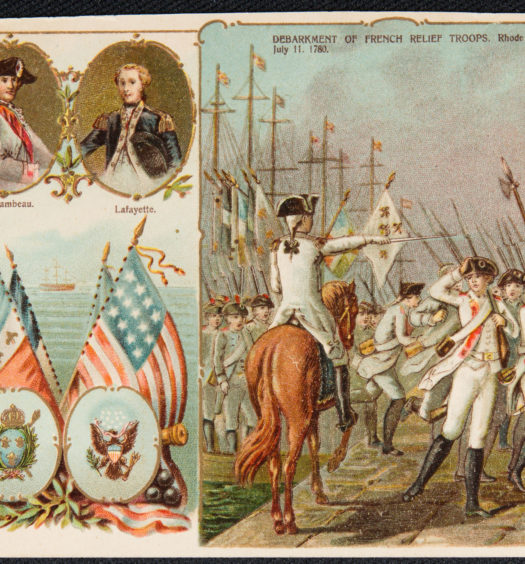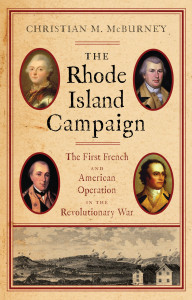Last spring, Patrick Donovan, the talented and hardworking curator at the Varnum Memorial Armory Museum in East Greenwich, announced his discovery of a handwritten letter from a formerly enslaved man who had gained his freedom by enlisting in the First Rhode Island Regiment during the Revolutionary War. The letter, written in 1781, appears to be one of only two[1] existing letters sent by a Black soldier from a Continental Army regiment during the Revolutionary War, and it was from a soldier serving in Rhode Island’s famous “Black Regiment.” This makes the find a remarkable one; indeed, it is a “national treasure” as Donovan states.[2] The contents of the letter are also noteworthy: the soldier makes a shocking request of his former “master and mistress” who had once enslaved him. This article is intended to place Thomas Nichols in context and to analyze the contents of his newly-discovered letter.
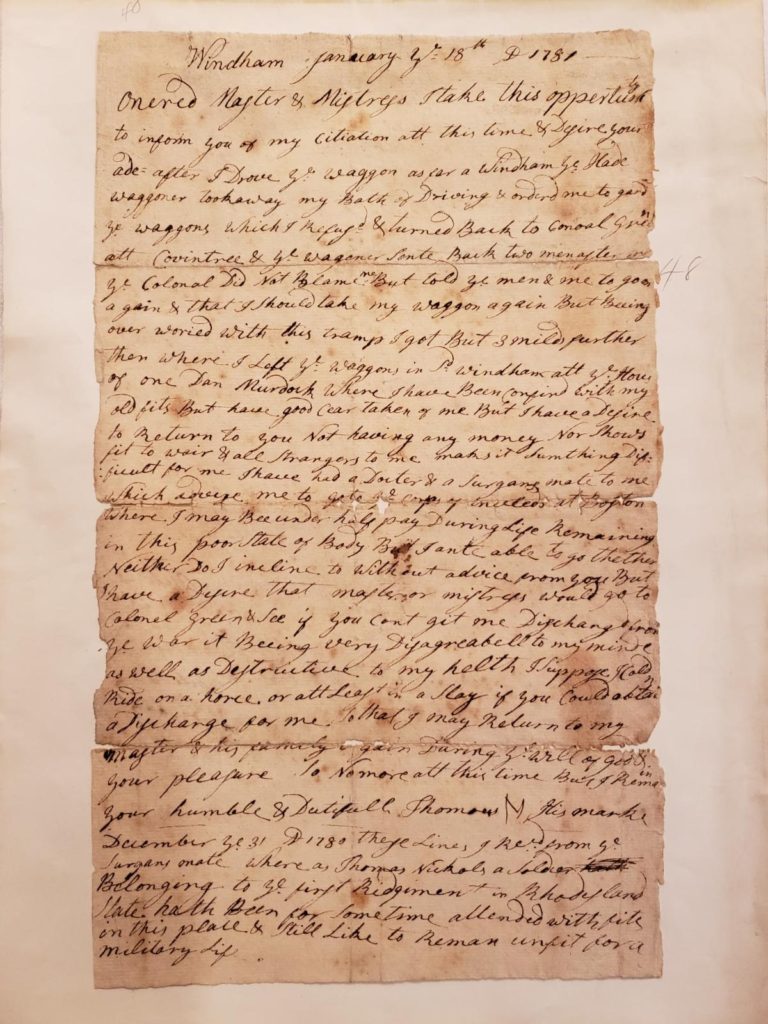
This was the state of the Thomas Nichols letter when found by Patrick Donovan last year in the archives of the Varnum Memorial Armory Museum at East Greenwich (Varnum Memorial Armory Museum)
The letter is from Thomas Nichols of Warwick. It was sent to Benjamin and Phoebe Nichols of Warwick, who had once enslaved Thomas Nichols. According to Rhode Island’s 1774 census, Benjamin had in his Warwick household two adult white men (himself and likely either his father or Phoebe’s father), two adult white women (Phoebe and likely her mother or Benjamin’s mother), three of their children, two Indian servants, and one Black slave—Thomas Nichols.[3] A state military census for 1777 listed Benjamin and Thomas as able-bodied men between the ages of sixteen and sixty. In mid-1778, Thomas Nichols became free, escaping enslavement by enlisting in the First Rhode Island Regiment of the Continental Army.
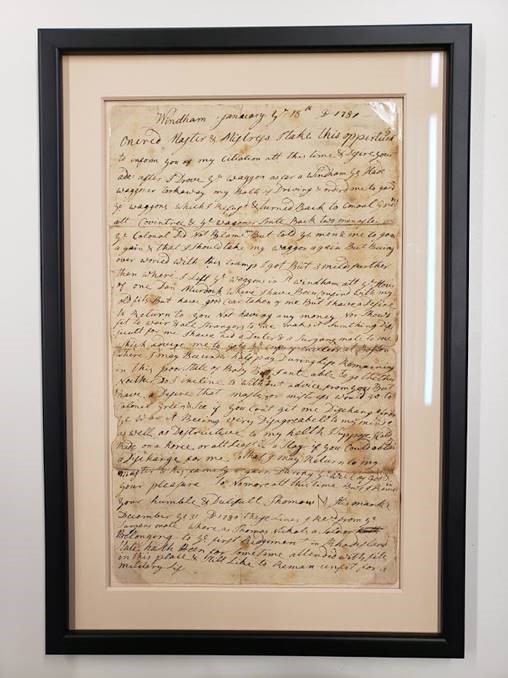
This shows the current display of the letter, after its restoration and placement in glass, thanks to a grant from the Rhode Island Sons of the American Revolution (Varnum Memorial Armory Museum)
The First Rhode Island Regiment was re-established in February 1778 in order to entice enslaved men to join its ranks. The idea likely originated from white officers of the regiment, whose ranks had been decimated from difficult military campaigns around New York City and Philadelphia. The idea also had the implicit support of General George Washington, who had forwarded the request to re-establish the regiment with enslaved men to Rhode Island’s governor.
On February 9, 1778, meeting at the East Greenwich courthouse, Rhode Island’s General Assembly enacted a law providing freedom to enslaved men who enlisted in the regiment. But there were a few important conditions. First, the enslaved man had to enlist for the duration of the war. Second, the enlistee’s former master or mistress was to be paid by the state an amount equal to the fair market value of the enslaved man, as determined by the state. In addition, the statute’s structure indicates that both the enslaved man and his owners had to agree to the enlistment.[4]
As it turned out, there were not enough enslaved young men in Rhode Island willing to enlist to fill a regiment. About ninety enslaved men did enlist, thus gaining their freedom. But more men were needed. Free Black men, Narragansett Indians, and other men of color filled out the ranks of privates. The officers were all white men, including the regiment’s colonel, Christopher Greene of Warwick.
On May 10, 1778, Thomas Nichols enlisted in the First Rhode Island Regiment and was assigned to Captain Thomas Cole’s company.[5] Nichols likely showed up at a muster organized by one of Cole’s white officers, with a drummer by his side to inspire the men with a drumbeat. Joining the regiment created a path to freedom, and so Nichols, along with other similarly minded enslaved men, voluntarily enlisted for the war’s duration. By virtue of joining the regiment, Nichols and the other enslaved men who had enlisted were now, according to the words of the statute, “immediately discharged from the service of his master or mistress” and “absolutely FREE.” In addition, they would now be fighting for the independence of the new United States.
I discovered that probably more than a dozen of these men had been born in Africa.[6] Now they would fight for the freedom of the country into which they had been forcibly carried.
On May 22, the State of Rhode Island issued a note in the amount of 120 pounds to Thomas’s former owner, Benjamin Nichols of Warwick. Thomas must have been healthy and strong, as 120 pounds was the maximum the state would pay owners of enslaved enlistees at the time.[7]
As with all the other enlistees, Nichols would have been inoculated against the smallpox at a safe house, probably in East Greenwich. Then military training with muskets and bayonets began in the town.[8] On May 31, 1778, Westerly’s Dr. Joshua Babcock wrote his friend, Benjamin Franklin, then in France, “This sable battalion, well uniformed and well conducted, bid fair for service.”[9]
The new soldiers in the First Rhode Island Regiment had little time to train or gain experience in the field before facing a fierce baptism of battle. This was at the Battle of Rhode Island, on August 29, 1778. As I describe in my book, The Rhode Island Campaign: The First French and American Operation of the Revolutionary War, the First Rhode Island Regiment held a key redoubt on the west side of Aquidneck Island at the most advanced—thus exposed—position of the American line. Three times experienced German troops, allies of the British, charged the redoubt and the American lines, and were repulsed by the First Rhode Island Regiment and other Continental regiments to their rear. One German officer stated, “we found obstinate resistance, and bodies of troops behind the work [the redoubt] at its sides, chiefly wild looking men in their shirtsleeves, and among them many negroes.”[10] Writing a few hours after the battle, First Rhode’s Island field commander in the battle, Major Samuel Ward, wrote, “I believe a couple of the blacks were killed and four or five wounded, but none badly.”[11] It was an impressive performance by the First Rhode Island, especially considering how inexperienced in combat the men were and that as enslaved men they had never been allowed to use guns or participate in militia exercises.
Thomas Nichols very likely fought at the Battle of Rhode Island in Portsmouth on Aquidneck Island. In a muster roll dated August 23, 1778, when the First Rhode Island Regiment was stationed on Aquidneck Island and just six days before the battle, Nichols is reported as “on guard” with the First Rhode Island Regiment. However, in the next month’s muster roll, he is reported as “Sick in hospital.”[12]
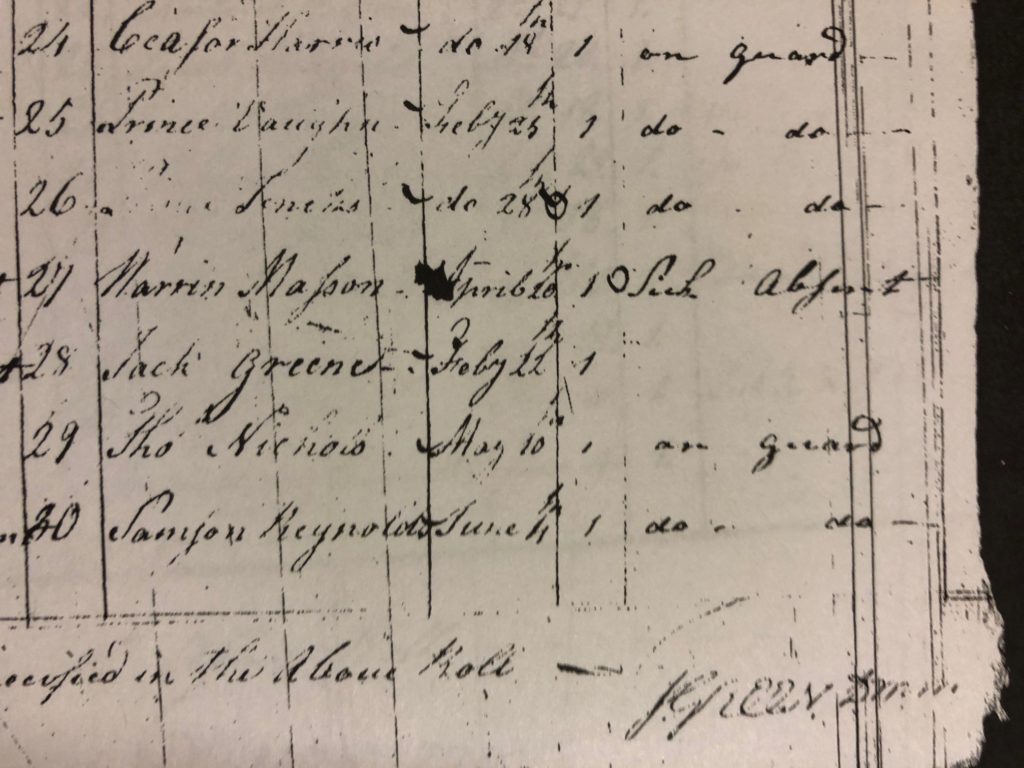
Thomas Nichols is listed on this muster roll for Thomas Cole’s Company of the First Rhode Island Regiment, dated August 23, 1778, as “on guard.” Thus, he must have fought at the Battle of Rhode Island six days later (Revolutionary War Muster Rolls, Rhode Island, National Archives)
It is not clear if Nichols had been wounded during the battle or suffered from an illness. Shortly before the battle, the regiment had suffered from an outbreak of disease, and Nichols may have become a victim of the outbreak after the battle.[13] During the war, on both sides, more soldiers died of disease than from bullets and cannon fire. Based on other descriptions in regimental muster rolls of Nichols as being “sick,” and that in his January 1781 letter Nichols states that he is suffering from illness and not from wounds, it appears more likely he became ill after the battle and was not wounded during the battle. Patrick Donovan appropriately wonders if Nichols suffered from PTSD syndrome.[13]
Nichols was still reported as “sick” in a muster roll return submitted in May 1779, at Quidnessett in North Kingstown. But he had apparently sufficiently recovered after that time to be listed in subsequent muster rolls as “on command” or “on guard”—that is, in a normal capacity.[14] Nichols was with his regiment when the British evacuated Newport and American regiments re-entered it in late October 1779. The muster roll for his company on January 7, 1780, from Newport, indicated Nichols was “on command.”[15] But a year later, by January 18, 1781, the date of the recently discovered letter, he had either suffered a relapse of his former illness or he had acquired a new debilitating disease.
Now let’s turn to Thomas Nichols’s letter. Here it is, with corrections made by me to misspellings and punctuation, and with a few words revised to reflect the intended meaning. (The original text of the letter is posted at the end of this article.) After the letter, I will address its substance.
Windham [, Connecticut,] January 18th, 1781
Honored Master & Mistress:
I take this opportunity to inform you of my situation at this time and desire your aide. After I drove 3 wagons as far as Windham, a wagoner took away my badge of driving and ordered me to guard the wagons, which I refused. I turned back to Colonel Christopher Greene at Coventry and the wagoner sent back two men after me. The Colonel did not blame me but told the men and me to go on again and that I should take my wagon again. But being over worried with this tramp I got but 3 miles further than where I left the wagons in South Windham at the house of one Dan Murdock where I have been confined with my old fits. But good care is taken of me. But I have a desire to return to you. Not having any money, nor clothes fit to wear and all strangers to me makes it something difficult for me. I have had a Doctor and a Surgeon’s Mate [examine] me who advise me to go to the Corps of Invalids at Boston, where I may be under half pay during the life remaining in this poor state of body. But I am not able to go there. Neither do I incline to do so without advice from you. But I have a desire that Master or Mistress would go to Colonel Greene and see if you can’t get me discharged from the war, it being very disagreeable to my mind as well as destructive to my health. I suppose I could ride on a horse or at least in a slay if you could obtain a discharge for me so that I may return to my master and his family again, bearing the will of God and your pleasure. So no more at this time. But I Remain your humble and dutiful Thomas.
“N” His mark
December 31, 1780. These lines I received from the Surgeon’s Mate: Whereas Thomas Nichols a soldier belonging to the First Regiment in Rhode Island State has been for some time attended with fits in this place and still likely to remain unfit for military life.
In the above letter, Nichols initially explains the incident that inspired his letter. The First Rhode Island Regiment was at the time stationed at Coventry, Rhode Island, and Nichols had been ordered to drive a wagon from there into Connecticut, probably to pick up grain or other foodstuffs and return it to Coventry for the troops. But during the trip, near Windham, Connecticut, Nichols must have become so incapacitated from the onset of an illness that he was unable to perform his assigned duty. A wagoner supervising him removed his badge that entitled him to drive a wagon for the Continental Army and ordered him to serve just as a mere guard for the wagons. Nichols refused the demotion and instead drove his wagon back to Coventry to meet with the commander of his regiment, Colonel Greene. Fortunately for Nichols, Greene did not punish him for disobeying orders. Rather Greene ordered Nichols to drive his wagon back to Connecticut and try to complete the task assigned to him. Nichols tried to do so, but he got no farther than three miles from South Windham when his illness again overwhelmed him. Luckily for Nichols, a local man, Dan Murdock, invited Nichols to stay at his house and took “good care” of him. At the time he wrote the letter, January 18, 1781, Nichols still suffered from his “old fits” and was not well enough to leave Murdock’s house.
Thomas desperately wanted to be discharged from military service. His reasons were that the war was “very disagreeable to my mind” as well as “destructive to my health.” Thomas no longer relished being a soldier and it had destroyed his health.
After providing Benjamin and Phoebe Nichols with this background, Thomas Nichols made the following startling request: “I have a desire to return to you.” Later he states (in the third person) that, for reasons of his poor health, “I have a desire that Master or Mistress would go to Colonel Greene and see if you can’t get me discharged from the war . . . .” He again reiterates his desire for his former owners to “obtain a discharge for me so that I may return to my master and family again . . . .”
Did Thomas Nichols want to be re-enslaved? It appears that is the case. The use of the terms “master” and “mistress” evoke the master-slave relationship. But it is not certain. Thomas did not use any other language indicating that he wanted to return to the legal status of enslavement. Perhaps Thomas was deliberately ambiguous. He may have wanted his former owners in the short term to take him back in and care for him, and at the same time defer until later negotiations with them over his free or unfree labor status.
Thomas Nichols must have been in a severe psychological state to have even intimated that he desired to return to a state of enslavement. But poor health, the pressures of war, and the uncertainty of his economic future due to his disability could explain a temporarily disturbed state of mind. Thomas apparently felt at the time that spending the rest of his days with his former master and mistress provided him with more security than struggling to live on his own in his unhealthy condition. It is also an indication that the white Nichols family were not cruel masters.
It is not certain that Benjamin and Phoebe Nichols could have re-enslaved Thomas, even if they had wanted to do so. There was no provision for it in the General Assembly’s legislation authorizing the re-establishment of the First Rhode Island Regiment. For Thomas to have obtained his freedom by enlisting, he had to enlist for the duration of the war. That condition implied that if a soldier deserted the regiment, he could be returned to slavery. But if the soldier was discharged for bad health that he acquired while on duty in his regiment or for battle wounds, the Rhode Island statute provided that such soldiers were not to be returned to slavery or required to be supported by their former owners, but instead would be supported by the state. (Rhode Island, however, had never implemented this last provision.)
In addition, Benjamin and Phoebe Nichols may not have wanted to re-enslave Thomas Nichols. At the time during the war, Rhode Island’s economy was in a shambles, and the white Nichols family may not have wanted another mouth to feed. In addition, they had allowed Thomas to enlist, a condition to receiving compensation from the State of Rhode Island for the his loss. They may have been concerned that the State of Rhode Island would demand repayment of a portion of the compensation that the State had paid to the Nichols family for Thomas enlisting in the First Rhode Island Regiment.
The situation is reminiscent of the implied moral obligation of slave masters to care for their elderly enslaved persons. In colonial times, it was considered cruel by masters to free an enslaved man or woman after a lifetime of unpaid service and at a time when he or she was too old or infirm to perform further useful work to support himself or herself. Thomas Nichols was in effect asking his former white owners to care for him at a time when he was unable to perform exacting manual labor. But as Benjamin and Phoebe may have viewed it, Thomas had not become incapacitated in their service; rather it was from his service in the Continental Army. At the time, the fledgling United States did not care for its wounded or ill veterans. Rhode Island had not begun to fulfill this obligation either. It thus became a matter of local government concern.
One reason Thomas Nichols found himself in this situation was because he had been enslaved. A typical white soldier would have had parents working on a family farm who made a decent living and could have taken their sick son in, cared for him, and nursed him back to health. Or other relatives could have done so. But Thomas Nichols’s parents likely continued to be enslaved persons and thus were not able to perform this crucial task that families sometimes are forced to undertake to assist their children. This was yet another penalty the slave system imposed on its victims.
In his letter, Thomas Nichols describes the “poor state” of his health and dire financial situation. He did not have “any money, nor clothes fit to wear . . . .” This was the fault, of course, of Congress and Rhode Island in failing to provide properly for their soldiers. Both white and Black soldiers suffered from such lack of support, especially beginning in the winter of 1778-1779 and for the remainder of the war. This sad state of affairs led to some mutinies among white soldiers, including in Rhode Island.[17]
Nichols also explains that he had been examined by his regiment’s doctor and a surgeon’s mate, both of whom agreed that Nichols was not fit to perform further military service. The postscript to the letter appears to be a paraphrasing of the conclusions of the surgeon’s mate. He concludes that Nichols “has been for some time attended with fits” and was “likely to remain unfit for military life.” However, the regimental surgeon and surgeon’s mate, rather than agree that Nichols should be discharged from military service, advised Nichols that he should be transferred to the “Corps of Invalids at Boston” where he could earn “half pay.” The Corps of Invalids was filled with Continental Army soldiers from various regiments who had suffered debilitating wounds or illness, making them unable to endure the rigors of a campaign. But they were deemed healthy enough to perform less demanding tasks, such as serving as guards.
It is not known if either Benjamin or Phoebe Nichols approached Colonel Greene about obtaining a discharge for Thomas Nichols. (It is noteworthy that Thomas was willing for Phoebe to make the request on her own, an indication of his confidence in her abilities.)
The muster rolls for the First Rhode Island Regiment indicate that Thomas Nichols was transferred to the Corps of Invalids on February 1, 1781.[18] Thus, Benjamin and Phoebe had little time to act before the transfer occurred.
Thomas Nichols wrote his mark on the letter with an “N.” Who penned the letter from his dictation is unknown. It was probably Dan Murdoch or someone who lived in his house or nearby. The letter writer could have been a Quaker, based on the frequent use of the word “ye.” Common soldiers not infrequently were illiterate and had other soldiers, often corporals or sergeants, write their letters for them. But in this case, Thomas Nichols was then in the house of a civilian and not at a regimental camp.

Thomas Nichols was not literate, so he signed his letter with the mark “N” (Varnum Memorial Armory Museum)
What happened with Thomas Nichols after war’s end is not known. The 1790 federal census of heads of households contains an intriguing clue. It does not mention a Thomas Nichols as a head of a household residing in Rhode Island. However, the 1790 census contains an entry for Benjamin Nichols residing in Warwick in a household of ten persons. It will be recalled that in the Rhode Island 1774 census, in addition to the seven white family members in Benjamin’s household, there were also recorded two Indians, who must have been free servants, and one Black person, who must have been the enslaved Thomas Nichols. In the 1790 federal census, Indians and Blacks were not categories. Instead, persons of color were covered by these two categories: “All other free persons” and “Slaves.” The entry for Benjamin Nichols in the 1790 census includes three white adult males, four white females, three free persons of color, and no slaves.[19] Accordingly, the size and makeup of the household was the same in 1790 as it was in 1774—seven whites and three persons of color. Perhaps the persons of color in the household in 1790 were the same two Indians were who in the Nichols household in 1774—and Thomas Nichols, but as a free man. If so, Thomas Nichols was granted his wish to return to the Nichols family, but he was able to negotiate his status to be a free man.
The 1790 census for Stratford, Connecticut, located in Fairfield County, contains the following item: “Thomas (Neg.) Nichols.” The term “Neg.” was short for the word Negro. This could be a reference to Thomas Nichols, formerly of Warwick, Rhode Island. The reference indicates that four other nonwhite persons resided in this household, likely the man’s wife and three children.[20] This record might tie into the fact that Thomas Nichols does not appear on a list of invalid soldiers residing in Rhode Island in 1785—perhaps he had moved to Stratford.[21]
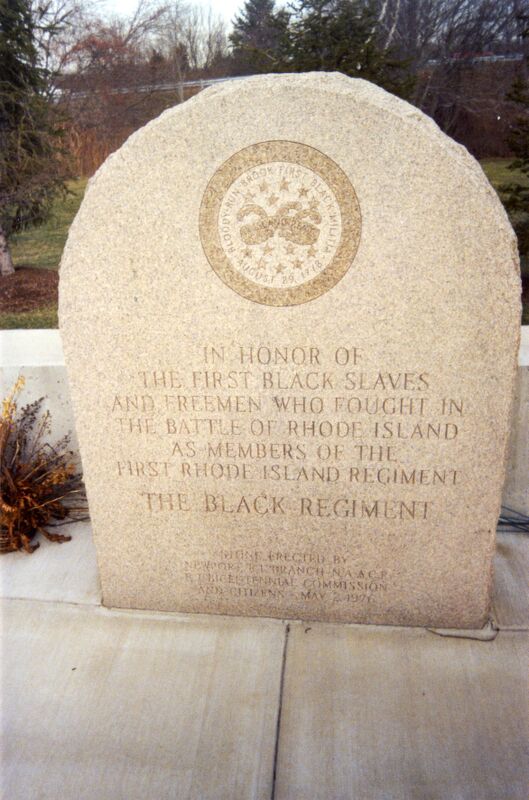
Memorial to the Black slaves and freemen who fought in the American army at the Battle of Rhode Island on August 29, 1778, in Portsmouth (Christian McBurney)
After this mention, the documentary record for Thomas Nichols is missing. It is not uncommon for the documentary record to be missing after a certain point in the late eighteenth century and early nineteenth century, either for a white or a Black person, but it was more likely to occur for Black persons. Thomas Nichols apparently did not live long enough to apply for a veteran’s pension in either 1818 or 1832. Perhaps his bad health arising from his military service finally caused his early death sometime after 1790. More research is needed to find out the rest of Thomas Nichols’s story after February 1781. (Due to the pandemic, I was not able to search by household federal censuses after 1790).
The Thomas Nichols letter has been professionally conserved by the Varnum Armory Memorial Museum, thanks to a grant from the Rhode Island Sons of the American Revolution. The letter is now on display in a frame in the museum’s 18th Century room. Patrick Donovan and the Varnum Armory Memorial Museum are to be congratulated on their spectacular discovery.
Appendix: The Original of the Letter, Uncorrected
Windham January 18th, 1781
Onered Master & Mistress I take this opportunity to inform you of my citiation att this time & desire your ade = after I drove 3 waggons as far as Windham I hade waggoner tookaway my badge of driving & ordered me to gard ye waggons which I refused & turned back to colonel green att Covintree & ye wagoner sent back two men after me Ye Colonal did not blame me but told ye men and me to go on again & that I should take my waggon again but being over worried with this tramp I got but 3 miles further than where I left ye waggons in So. Windham att ye house of one Dan Murdock where I have been confined with my old fits But have good care taken of me But I have a desire to Return to you Not having any money Nor Clows fit to wair & all strangers to me makes it something difficult for me I have had a Doctor and a Surgans mate to me which advize me to go to xxx corps of invalids at Boston where I may be under half pay During Life Remaining in this poor State of Body But I ante able to go thether Neither do I incline to with out advice from you But I have a desire that Master or Mistress would go to Colonel Green & see if you cant git me Discharged from ye War it being very Disagreabell to my mind as well as Destructive to my helth I suppose I could ride on a horse or att least in a Slay if you could obtain a Discharge for me So that I may Return to my Master and his family again baring[?] the will of god & your pleasure So No more att this time But I Remain your humble & dutiful Thomas.
“N” His mark
December 31 1780 These lines I recv’d from ye Surgeon’s mate where as Thomas Nickols a soldier belonging to ye first Regiment in Rhode Island State hath been for some time attended with fits in this place & still likely to Remain unfit for military life.
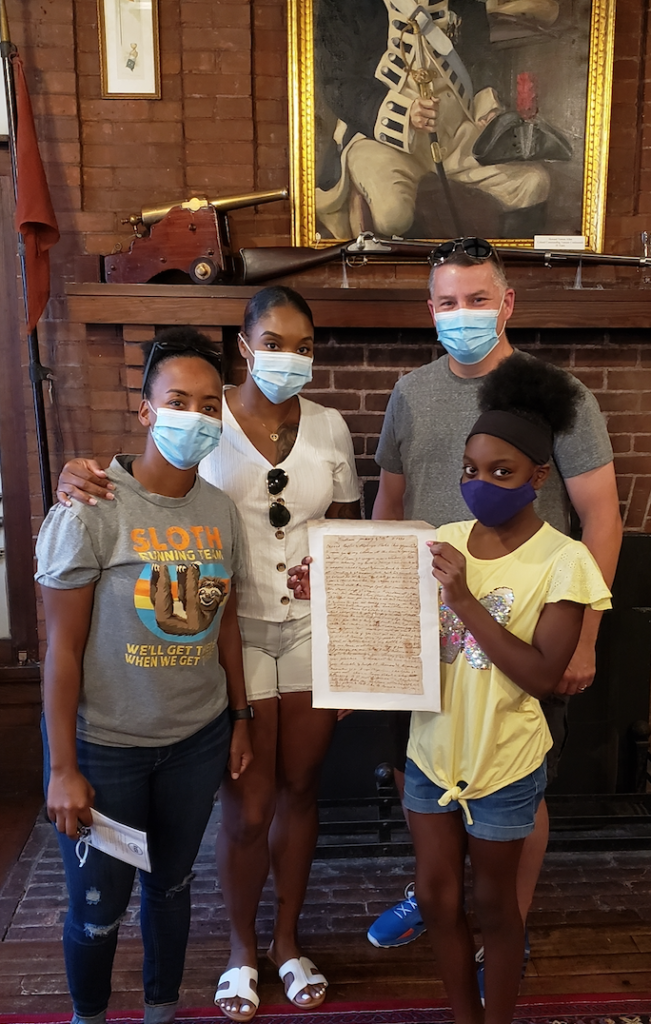
In the time of Covid, Patrick Donovan stands with two Army soldiers visiting the Varnum Memorial Armory, while the daughter of one of the soldiers holds the restored Thomas Nichols letter, on the first day Donavan put the letter on display (Varnum Memorial Armory Museum)
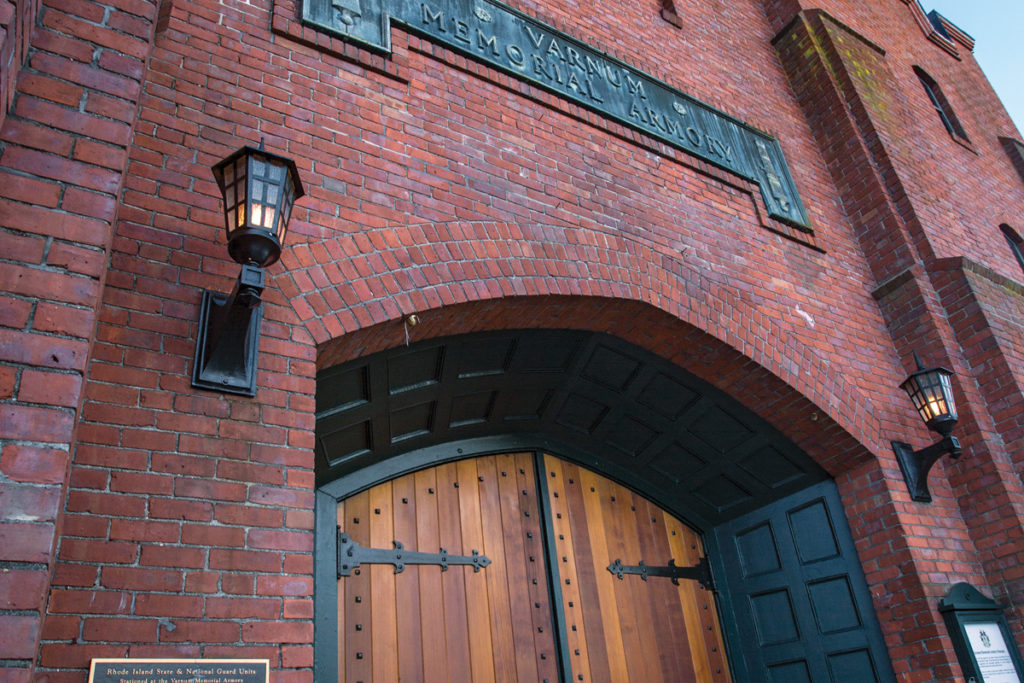
The entrance to the Varnum Armory Memorial Museum on Main Street in East Greenwich. With the find of the Thomas Nichols letter, the museum solidifies its status as the premier military museum of Civil War and pre-Civil War artifacts in Rhode Island (Varnum Memorial Armory Museum)
[Banner image: Excerpt from the Thomas Nichols letter (Varnum Armory Memorial Museum)]
Notes
[1] The other letter, dated September 30, 1776, was sent by Caesar Phelps to his master, Charles Phelps. Charles Phelps from Hadley, Massachusetts, owned large farms in the Connecticut Valley. In 1776, Charles Phelps sent Caesar in his place to fight in a Massachusetts Continental Regiment. It was not uncommon for white men, when drafted to serve in the army, to send an enslaved man in their place. Typically, the Black soldier was required to share his wages with his white owner. In the surviving letter from Fort Ticonderoga in New York State, likely written by a literate fellow soldier, Caesar Phelps complained to his master that he was not receiving his share of the wages. See Letter from Sezor (Caesar) Phelps to Charles Phelps, Porter-Phelps-Huntington Family Papers, Box 4 Folder 12, Amherst College Archives and Special Collection. For more on this letter see the online article, Cara Hudson-Erdman, “Caesar Phelps,” The Porter-Phelps-Huntington House Museum, at https://www.pphmuseum.org/slavery-and-servitude-at-forty-acres-blog/2018/6/27/caesar-phelps. The article states that Phelps served in a Continental Army regiment, but did not identify it. Phelp’s letter mentions that Phelps served under Captain Cranston. Cranston served in Colonel Asa Whitcomb’s Regiment, 6th Continental Regiment (and Massachusetts 13th Regiment) of the Continental Army. Whitcomb’s Regiment served in northern New York in the summer and fall of 1776. See Francis B. Heitman, Historical Register of Officers of the Continental Army During the War of Revolution (Washington Press, 1893), p. 139 (Abner Cranston served as captain in Whitcomb’s Massachusetts Regiment, from May to December 1775, and in the 6th Continental Regiment from January 1 to December 31, 1776); Massachusetts Society of Sons of the American Revolution, Historical Memoranda with List of Members and Their Revolutionary Ancestors (Boston, MA: Published by the Society, 1897), p. 166 (Corporal John Ashby of Salem Massachusetts served in Captain Cranston’s Company, Colonel Whitcomb’s Regiment, as “was at Ticonderoga in 1776,” citing Rev. Rolls, Mass. Archives); “Massachusetts Line,” in Wikipedia at https://en.wikipedia.org/wiki/Massachusetts_Line. Professor Joanne Melish informed me about the Caesar Phelps letter. [2] Patrick Donovan, “Thomas Nichols Letter at the Varnum Armory . . . a Stunning 18th-Century African American Artifact,” Feb. 11, 2021, online article at the Varnum Continentals website at http://varnumcontinentals.org/2021/02/feature-article-thomas-nichols-letter-at-the-varnum-armory-a-stunning-18th-century-african-american-artifact/. Donovan’s discovery was highlighted in a front page article, Paul Edward Parker, “Echoes of the Past,” Providence Journal, Feb. 15, 2021, p. 1. [3] See John R. Bartlett, ed., Census of the Inhabitants of the Colony of Rhode Island and Providence Plantations 1774 (Providence, RI: Knowles, Anthony & Co., 1858), 64; Mildred M. Chamberlain, ed., The Rhode Island 1777 Military Census (Baltimore, MD: Genealogical Publishing Co., 1985), p. 119. The original source for Benjamin being the owner of Thomas is the General Treasurer’s Accounts cited in note [7] below. The name of Benjamin’s wife is dervied from Patrick Donovan’s article cited in the first note above. [4] See General Assembly Resolution, Feb. 9, 1778, in John R. Bartlett, ed., Records of the Colony of Rhode Island and Providence Plantations, vol. 8 (Providence, RI: A. C. Greene & Bros., 1863), 358-60. For more on the First Rhode Island Regiment, see Robert Geake and Lorén Spears, From Slaves to Soldiers: The 1st Rhode Island Regiment in the American Revolution (Yardley, PA: Westholme Publishing, 2016); Daniel M. Popek, They “… fought bravely, but were unfortunate:” The True Story of Rhode Island’s “Black Regiment” and the Failure of Segregation in Rhode Island’s Continental Line, 1777-1783 (Bloomington, IN: AuthorHouse, 2016). [5] See Thomas Nichols Service Records, Derived from Company Muster Rolls July 6, 1778-May 4, 1781, in Compiled Service Records of Soldiers Who Served in the American Army during the Revolutionary War, M881, Washington, D.C.: National Archives, Washington, D.C. (hereafter “Thomas Nichols Service Records”). [6] An incomplete muster roll lists thirty-three former enslaved soldiers from the First Rhode Island Regiment and describes eight of them has being born in Africa and one as being born in Jamaica. List of Soldiers, 1781, Regimental Book, Rhode Island Regiment, 1781-83, microfilm, R.I. State Archives. While this regimental list was compiled in 1781, it contains information relating to privates who had enlisted in the First Rhode Island in 1778. [7] An Account of the Negro Slaves Enlisted into the Continental Battalions, to whom they belong, with the valuation of such Slave, and Notes Given, General Treasurer’s Accounts, 1761-1781, Alphabetical Book, No. 6, R.I. State Archives. Bartlett, ed., Records of the Colony of R.I., 8:360. [8] Christian McBurney, The Rhode Island Campaign: The First French and American Operation of the Revolutionary War (Yardley, PA: Westholme, 2014), p. 48. [9] Quoted in ibid., p. 48. [10] Quoted in ibid., p. 188. [11] Quoted in ibid., p. 245. [12] Muster Roll for Thomas Cole’s Company, Aug. 23, 1778, First R. I. Regiment, Revolutionary War Muster Rolls, Rhode Island, 1777-80, National Archives; Thomas Nichols Service Records, Sept. 1778 (“Sick in hospital”); Dec. 1778 (“Sick Absent”); Jan. 1779 (“On duty”); Feb. 1779 (“Under guard”); April 1779 (“On guard”); May 1779 (“Sick” at Quidnessett); July 1779 (“On Guard”); Aug. 1779 (“On Guard”). [13] McBurney, Rhode Island Campaign, 199. [14] Same cite as in first note above. Daniel M. Popek, in his exhaustively researched work on the First Rhode Island Regiment, after studying the evidence he uncovered about the battle, leaned towards Thomas Nichols being among the regiment’s men wounded in the battle. Popek, The True Story of the “Black Regiment,” 233-34. [15] Thomas Nichols Service Records, Aug. 1778 to Dec. 1779. [16] Ibid., Nov.-Dec. 1779. [17] See Christian McBurney, “Mutiny! American Mutinies in the Rhode Island Theater of War, September 1778-July 1779,” Rhode Island History, vol. 69, No. 2 (Summer/Fall 2011), pp. 47-72. [18] See Thomas Nichols Service Records, Feb. 1780 to May 1781. Another source indicates that the transfer occurred on March 1, 1781. See Bruce C. MacGunnigle, Regimental Book: Rhode Island Regiment for 1781 &c. (East Greenwich, RI: Rhode Island Society of the Sons of the American Revolution, 2011), p. 71. [19] Heads of Families at the First Census of the United States Taken in the Year 1790, Rhode Island (Bureau of Census, ed.) (Washington, D.C.: Government Printing Office, 1908), p. 14 (under Warwick). Curiously, there is no mention of Benjamin Nichols’s household in a Rhode Island 1782 census. See Jay Mack Holbrook, Rhode Island 1782 Census (Oxford, MA: Holbrook Research Institute, 1979). [20] Heads of Families at the First Census of the United States Taken in the Year 1790, Connecticut, p. 31. This reference was mentioned in Eric G. Grundset, ed., Forgotten Patriots, African American and American Indian Patriots in the Revolutionary War (National Society of the Daughters of the American Revolution, 2008), p. 223. No Black man named Thomas Nichols was reported as a soldier in the Revolutionary War hailing from Connecticut. See ibid, pp. 270-295. [21] List of Invalids, June 7, 1785, in Bartlett, ed., Records of the Colony of R.I., 10:162-67. The list includes several Black soldiers of the First Rhode Island Regiment.


